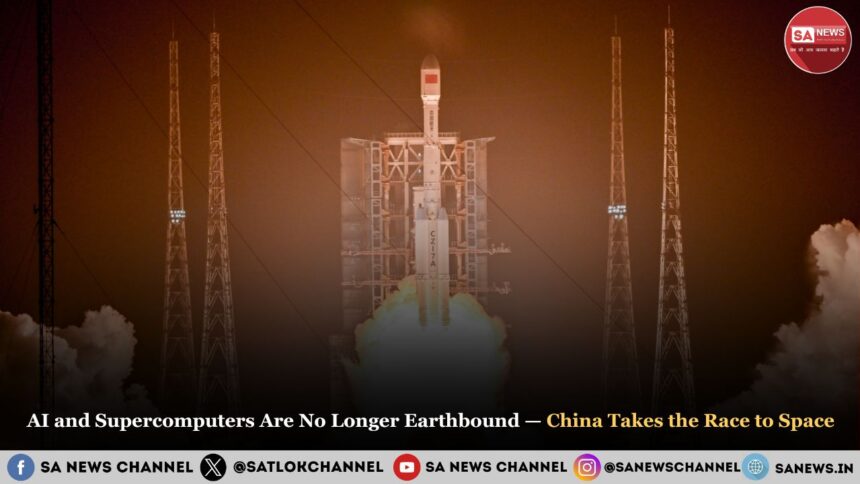- China launched its first batch of 12 AI-powered satellites as part of the world’s first space-based supercomputer project.
- The mission marks an unprecedented advancement in off-Earth data processing capabilities.
- A total of 2,800 satellites are planned under this project.
- This initiative is expected to trigger a new global space-tech race.
AI-Powered Satellites: A New Frontier in Space Computing
Under the “Three-Body Computing Constellation,” China has launched 12 AI-equipped satellites. Each satellite carries a trained AI model with 8 billion parameters. Together, these satellites can deliver 5 Peta Operations Per Second (POPS), with scalability up to 40 POPS. China aims to achieve 1,000 POPS by deploying thousands more.
- AI-Powered Satellites: A New Frontier in Space Computing
- Data Processing in Space: A Paradigm Shift
- Why Space-Based Supercomputing Is a Game Changer
- Global Reaction: The Beginning of a New Space Race
- Satlok: The Eternal Realm Beyond Science and Space
- China has begun building the first supercomputer in space (FAQs)
Data Processing in Space: A Paradigm Shift
Unlike traditional satellite systems like Starlink that rely on Earth-based processing, these new AI satellites process data directly in space.Benefits include:
- Reduced latency
- Real-time autonomous decision-making
- Minimal reliance on Earth-based infrastructure
Why Space-Based Supercomputing Is a Game Changer
1. Latency Reduction and Real-Time Processing
In-space data processing removes the delay of sending data back to Earth, enabling faster decision-making and execution.
2. Global High-Speed Internet
The satellite network can offer ultra-fast internet in remote and under-connected regions, improving bandwidth and connectivity.
3. Reduced Physical Space Requirements
Earth-based data centers require massive infrastructure and account for around 3 percent of global energy use. Space-based systems eliminate these needs.
4. Natural Cooling Advantage
The near-freezing conditions of outer space (approximately -270°C) naturally help cool supercomputers, eliminating the need for extensive cooling infrastructure.
5. High-Speed Data Sharing
These satellites are equipped with tools like X-ray polarization detectors and can share data at speeds of 100 Gb/s, with each satellite capable of handling up to 30 terabytes of shared storage.
Global Reaction: The Beginning of a New Space Race
China’s move has inspired awe and concern worldwide, initiating a new era of space-based technology competition. Other nations may now begin investing in orbital supercomputing and AI networks, marking a global shift in how data infrastructure is designed and deployed.
Satlok: The Eternal Realm Beyond Science and Space
While scientists are expanding human reach into space, spiritual scriptures describe a realm far beyond scientific access Satlok, the eternal, divine world.
Located an estimated 16 sankh kos (roughly 100 trillion kilometers) from Earth, Satlok is free from death, suffering, and decay. No rocket or telescope can find it. It is only accessible through the true devotion of the Supreme God, as explained in ancient sacred texts.
To learn about this eternal realm and the correct method of worship, visit: https://www.jagatgururampalji.org/en/articles/post/satlok-heaven
China has begun building the first supercomputer in space (FAQs)
1. What does POPS mean?
POPS stands for Peta Operations Per Second, which is a unit of computational speed equal to one quadrillion (10¹⁵) operations per second.
2. What is the fastest recorded data transmission speed on Earth?
Researchers in Japan achieved a speed of 1.02 petabits per second using multi-core optical fibers, enough to stream over 10 million 8K videos simultaneously.
3. How is data shared through laser in space?
Laser data transmission involves modulating laser beams to encode and send data between satellites or stations.
4. What factors influence laser-based data transfer speeds?
Atmospheric interference (like fog and rain), alignment precision, and modulation quality significantly impact performance.
5. What is quantum internet?
Quantum internet uses entangled quantum particles to transmit data securely, offering unbreakable encryption and fundamentally new communication capabilities.









